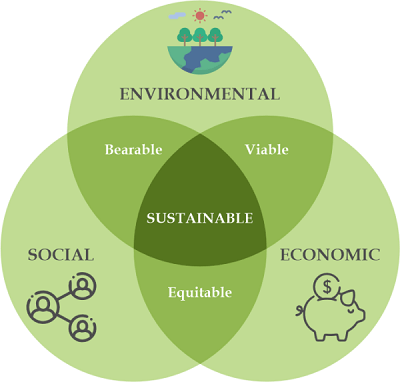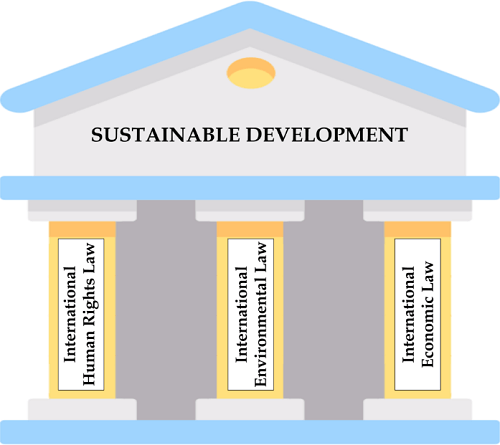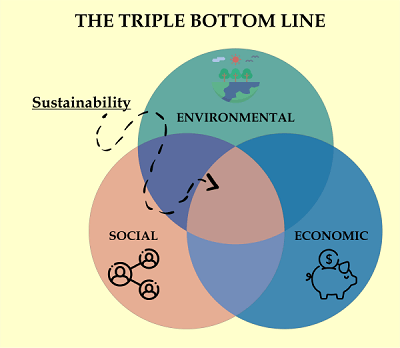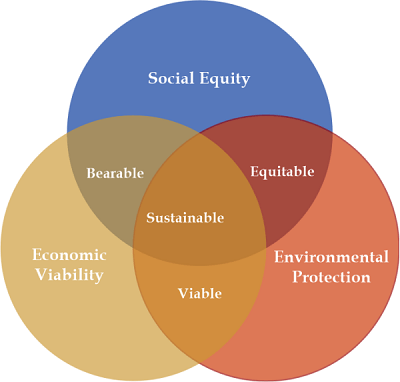The 3 Pillars of Corporate SustainabilityWhat is Corporate Sustainability?Corporate sustainability is a well-known topic in both large and small businesses. Sustainability has been cited as a top goal moving ahead by several corporate behemoths, including Walmart Stores, Inc. (WMT), McDonald's Corporation (MCD), and many more. Other businesses are now being pushed to make a commitment to developing environmentally friendly ways to distribute their products and services. 
The world has moved to embrace sustainable practises and policies as worries about anthropogenic weather change, habitat loss, and pollution. All these have grown more widespread. They have primarily been accomplished through adopting sustainable business practices and investing heavily in green technology. However, the definition of "business sustainability" is not immediately evident. The three main components of a company sustainability plan include Environmental, Social and Economic. Key Takeaways
Understanding Corporate Sustainability
ESG, or ecosystem, social, and governance practises, are the general term for corporate sustainability practises. ESG is used by businesses to lessen their environmental impact or to achieve other socially beneficial goals. SRI, or socially responsible investment, is relevant here. The most common definition of sustainability is "fulfilling existing demands without sacrificing the capabilities of succeeding generations to satisfy their own needs." In general, a business adopts sustainable practices by cutting back on the use of finite resources or by identifying substitutes that have less of an impact on the environment. The three fundamental pillars of sustainability are economic, environmental, and social. Humans, planet, and profits are the three pillars' colloquial names. The Environmental PillarThe environmental component frequently receives the most significant focus. Many businesses are working to minimize water use, packaging waste, carbon footprints, and other environmental harm. These actions can benefit the economy in addition to the environment. Reduced costs of packaging materials, for instance, and increased fuel economy also assist the company's budget. In a recent instance, Walmart focused on packaging as part of its zero-waste campaign, urging suppliers to use less packaging overall and to obtain more packaging from recycled or repurposed materials. A company's influence is frequently not wholly costed, which means that there are repercussions not included in consumer pricing, which is one of the difficulties with the environmental pillar. Because businesses are only sometimes held responsible for the garbage they make, it is difficult to estimate the total expenses of sewage, carbon dioxide, land acquisition, and waste in general. To quantify such externalities so that the work being made to reduce them can be tracked and documented in a meaningful way, benchmarking is used in this situation. The Social PillarThe social pillar is related to the social licence, another ill-defined idea. Employees, shareholders, and the community in which a firm operates should all be in favour of it. There are many ways to gain and keep this support, but ultimately it boils down to treating workers fairly and acting responsibly in local and global communities. Businesses are refocusing their efforts on employee retention and engagement methods, offering more flexible perks such as excellent maternity and family amenities, flexible scheduling, and chances for learning and development. Companies have developed various strategies to give back to the community, including fundraising, sponsorship, scholarships, and investment in regional public initiatives. A company should be attentive to how its distribution system is being filled on a worldwide social scale. Is child labour used to produce the finished goods? Does everyone receive a fair wage? Is the workplace secure? Public outcry over calamities like the Bangladesh mill collapse, which highlighted previously unaccounted-for hazards in procuring from the lowest-cost supplier, has caused many significant retailers to grapple with this. The Economic Pillar
Most firms consider their footing to be secure in the economic pillar of sustainability. A firm has to be lucrative to last. Profit, however, cannot be put above the other two principles. The financial component is not about maximizing profit at any cost. Compliance, effective governance, and risk assessment fall within the economic pillar. While most North American businesses consider these as the minimum requirements, they are not the industry norm. This pillar is sometimes called the administration pillar to emphasize/ sound corporate governance. This indicates that the interests of shareholders, the company's communities, value chains, and end-user consumers are aligned with those of the boards of managers and directors. Investors may be interested in the governance of a firm, including whether or not it employs accurate and open accounting practices. It allows stockholders to participate in voting on significant matters. They may also seek guarantees that businesses won't choose board members with conflicts of interest, won't utilize political donations to get preferential treatment, and won't participate in unlawful activity. Corporate adoption of sustainability solutions is made feasible by incorporating the economic pillar and profit. The economic pillar checks against excessive steps businesses may be pressured to take, including immediately quitting fossil fuels or chemical fertilizers instead of gradually adjusting. The Impact of Sustainability
"Whether sustainability benefits a firm" is the primary concern for investors and management. Every sustainability strategy has been appropriated from other corporate movements like Kaizen, community involvement, the BHAG (Big Hairy Audacious Goal), talent development, etc. Companies may reinvigorate their commitment to fundamental objectives like effectiveness, sustained growth, and shareholder value by focusing on sustainability, giving them a bigger goal and more deliverables to aim for. Perhaps more significantly, a sustainability plan that is widely publicized can bring about intangible advantages like improved reputation and public goodwill. Why not if it allows a business to receive credit for previously completed work? However, there is no current market repercussion for organizations unable to articulate a comprehensive plan to move forward in these three areas (social, economic and environmental). Similar to regulation for publicly traded firms, the trend is establishing sustainable development and public adherence to its fundamental business practices. If this occurs, firms without a sustainability strategy can experience a market penalty instead of proactive enterprises seeing a market advantage. Some businesses see sustainability as a chance to unify several initiatives under one overarching idea and get recognition. To some companies, achieving sustainability entails confronting complex issues about the nature and purpose of their business processes that may have a significant, if slow-moving, influence on their operations. What is Corporate Sustainability Reporting?Corporate sustainability reporting is the practice of businesses frequently disclosing their sustainability objectives and tracking their progress toward attaining them so that the general public can better understand how the industry promotes a sustainable global economy. The usage of resources by the company, environmental consequences of operations, both positively and negatively, and future sustainability plans may all be covered in sustainability reports. How does Sustainability affect Corporate Governance?The administration pillar of sustainability refers to measures that maintain a company's core values in line with those that govern society, such as truthful accounting, openness, and regulatory compliance. The importance of the business must also coincide with those of the communities, supply networks, and end-user clients. What are some benefits of Corporate Sustainability?Supporting the community and the environment has many positive social effects, but sustainable business practices may also increase earnings over the long run. For instance, implementing policies advantageous to the company's workers and community can boost its reputation and raise its potential clients' disposable income. In the long term, this might lead to more individuals purchasing the company's goods. The Bottom LineA company's complete supply chain must be accountable for sustainability, starting at the primary level and continuing through the suppliers and retailers. Some international supply chains that have grown up entirely based on low-cost production may need to be reorganized if manufacturing something environmentally becomes a competitive advantage for supplying multinational firms. Of course, how firmly firms support sustainability, whether it is a genuine change in direction or lip service, will determine whether that scenario occurs. Despite all the facts, it is clear that the 3 pillars of corporate sustainability are essential to most businesses. |
 For Videos Join Our Youtube Channel: Join Now
For Videos Join Our Youtube Channel: Join Now
Feedback
- Send your Feedback to [email protected]
Help Others, Please Share









